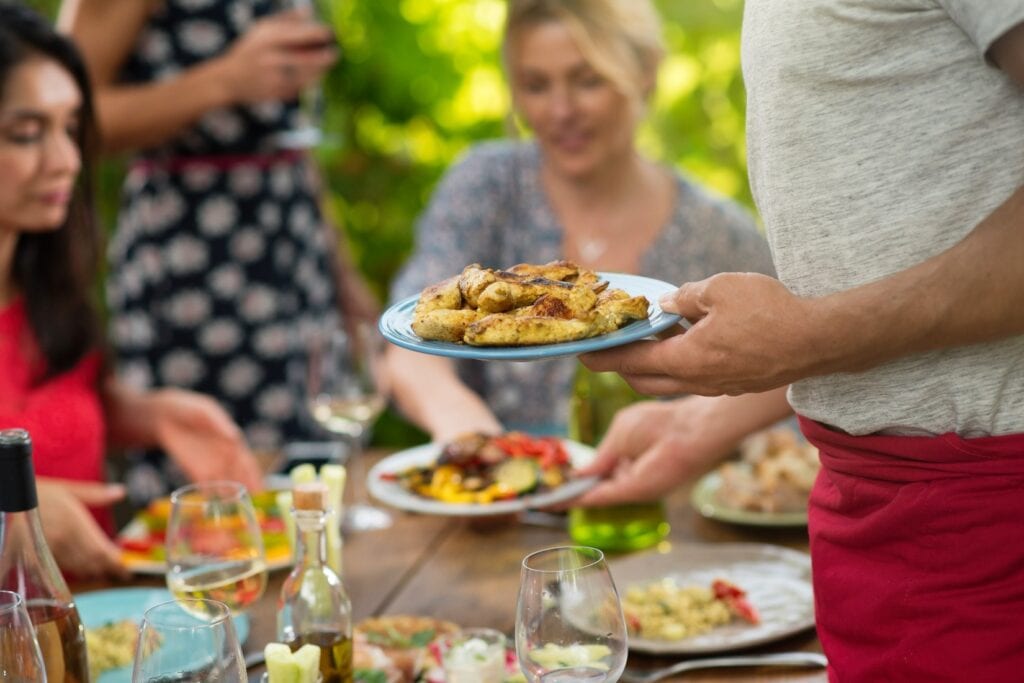Chapter 2 — Outdoor Kitchen Guide
Your new outdoor kitchen is so close that you can almost taste those perfect grill marks on your next steak. You can’t help but visualize your family playing in the backyard as you cook a hearty meal, enjoying that much-desired outdoor time with them. Yet there’s still one thing missing—where are you going to put everything?
When it comes to outdoor kitchen designs for your new space, there’s a lot to consider. Even if you’ve already decided on the placement of your kitchen and appliances, there’s at least one more aspect that LanChester Grill & Hearth suggests looking at: kitchen zones.
In this second chapter of our outdoor kitchen plans series, we’re sharing the four types of kitchen zones: cooking, prep, plating/serving, and entertaining. Each of these zones can also be classified as either hot, cold, wet, or dry, and they will help keep your outdoor cooking as organized as possible.
Cooking Zone
The first, and probably most important, zone is your cooking zone. This is a hot zone and contains your grill, oven, smoker, pizza oven, cooktop, or any other appliance you plan on using for outdoor cooking. It’s important that this zone has plenty of space for when you’re cooking. Nothing is more frustrating than running to the other end of the counter for an ingredient or shoving things together to try and optimize more counter space.
LanChester Grill recommends side burners for grills and storage space for propane tanks and cooking utensils. The side burners will give you more space to cook, but can also work as a place to keep your food warm. Having plenty of cabinets and drawers will allow you to hide unsightly propane tanks or wires, as well as store outdoor cooking utensils so you don’t have to run inside when you forget to grab a spatula.
Prep Zone
Any good cook knows that keeping raw foods away from cooked foods is extremely important. When you’re working on your outdoor kitchen plans, make sure that there is plenty of space between your cooking and prep zones. As a wet zone, consider having your sink, freezer, and waste disposal all in this area. Not only will it help with prep and clean-up, but it will also help keep anything from getting contaminated.
The prep zone is also a good area to keep any sealed, dry storage items you may need to use frequently. Dishes, glasses, paper towels, cutting boards, and even dry food can be easily stored in drawers or cabinets in this area, so take that into consideration with your outdoor kitchen designs.
Plating & Serving Zones
After your food is prepped and cooked, the next step is plating and serving. If you already have your prep area dedicated to non-food items like cleaning supplies, the plating and serving area is the next best zone to store your dishes and glasses. That way, when you’re ready to serve food, it’s as easy as getting plates out of a cabinet near the grill.
In addition to dish storage, consider installing warming trays or drawers to help keep food at the desired temperature before you’re ready to serve. If you don’t already have cold storage in your prep area, the plating and serving zones are great for refrigerators for drinks as well. Having a good balance of both dry and cold storage will be essential in your outdoor kitchen plans. If your outdoor area has a space constraint, storage will be even more important in order to optimize your outdoor cooking and keep pathways clear.
Entertaining Zone
If you plan on having friends and family over for plenty of cookouts, this last zone may be the most important to you. Some outdoor kitchen designs have less cooking space to accommodate bartending or food serving space. If that sounds like your ideal design, consider moving cold storage to this zone and keeping it close to your plating and serving area. Appliances like wine coolers, kegerators, ice machines, and blenders are perfect for the entertaining zone. Also, depending on how much bartending will be involved, an extra small sink in this area may not be a bad idea.
Don’t forget to consider counter space and layout for this area of your outdoor kitchen. If you have barstool seating, you may want to have a tiered counter so that your guests have more leg room, but also so you’re not preparing drinks on the same level that they’ll be leaning on and eating at.
No matter what route you go with your outdoor kitchen plans, know that the professionals at LanChester Grill are here to help you every step of the way. Outdoor cooking is our passion, and we want to make sure that the layout of your outdoor kitchen is efficient and optimized for all of your needs. Get in touch with us today to start your big project!
Also remember to check out Chapter 3 in our outdoor kitchen planning series: Selecting Your Outdoor Kitchen Appliances!


